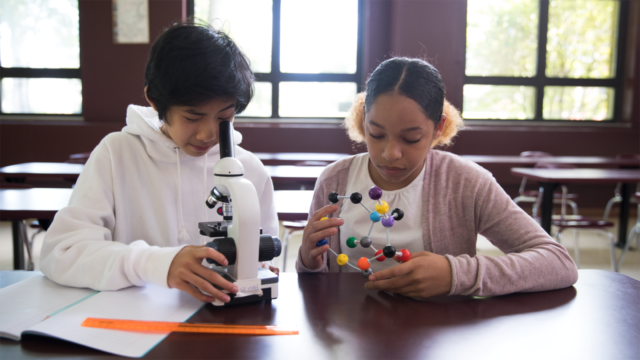
Learning about science through listening to lectures and reading about it, though valuable, isn’t always enough to truly engage students. Learning by doing science through hands-on science activities and experiments lets students see what they’ve learned in action and develop a deeper understanding of the subject. Hands-on learning is just another way to refer to learning by doing. Allowing students to discover more about scientific concepts through hands-on science activities, experiments, and projects is a proven way to increase engagement and academic achievement.
What Is Hands-On Science?
Hands-on science can be defined as students getting their hands on materials, performing experiments, exploring phenomena, and trying out ideas. According to research, hands-on science usually involves “physical materials to give students first-hand experience in scientific methodologies” but can also include virtual labs. Labs, experiments, and projects are all potential hands-on science activities.
Why Hands-On Learning Is Important in Science
Hands-on learning is more than just a way to get students to experiment with science equipment or be immersed in a virtual world. Also, hands-on learning does more than bring fun to learning. This approach is proven to increase student engagement and understanding of scientific concepts.
Hands-on learning can also connect to inquiry-based learning in science, another teaching approach that’s proven to increase student engagement. Inquiry-based science instruction encourages students to ask questions they are interested in and investigate those questions. Hands-on science is one of many ways students can explore inquiries, whether the procedure is designed by the teacher or student. Let’s delve into the additional benefits of hands-on learning in science.
Benefits of Hands-On Learning in Science
Increases Retention: Active learning, such as through hands-on activities, has been proven to be effective at promoting retention. When students apply what they’ve learned in the classroom through hands-on science experiments and activities, students can better understand concepts.
Improves Performance on Assessments: Research from the University of Chicago shows that hands-on science can improve student outcomes. Participating in the learning process through learning by doing helps students forge a deeper understanding of the scientific concepts taught in class.
Provides a Sense of Accomplishment: Teachers have recognized that hands-on science provides students with a sense of accomplishment. At the end of a hands-on activity or experiment, students can see the immediate results of their learning. Learning new ideas can take a long time, but when the learning is hands-on, students reach a clear stopping point and can look back at what they did.
Supports Students with Learning Barriers: Hands-on learning is a proven way to support students with learning barriers, such as multilingual learners and students with autism. Research has shown that students who are just beginning to learn English can benefit from visual resources and hands-on activities that help them understand new words and concepts in English. Additionally, research has shown that hands-on learning can enhance the learning process for students with autism.
Develops Critical Thinking Skills: Overall, hands-on learning develops students’ critical thinking skills. Through doing hands-on activities and experiments, students have the chance to connect to and apply what they’ve learned in class to complete their projects.
Tips for Designing Hands-On Science Lessons
There are various angles teachers can take to incorporate hands-on learning into the science classroom. For example, if using the 5Es of science model for instruction, teachers can integrate hands-on activities and experiments into the explore stage. Additionally, if setting up multiple science centers in the classroom, each center might feature a hands-on science activity so that students can practice different science concepts.
When designing hands-on science lessons, consider these tips:
- The activities and experiments should reinforce scientific concepts students encounter in class and align with standards.
- Promote teamwork and collaboration during lessons to strengthen communication and cooperative learning.
- Incorporate formative assessment in science through hands-on performance tasks that provide the chance to gauge student understanding.
Fun Hands-On Science Activities and Experiments
Another way to utilize hands-on science in your classroom is through implementing ready-to-use lessons, such as those from HMH science programs. The following four hands-on activities and experiments provide students with the chance to see scientific concepts in action. Additionally, some of the activities let students collaborate with their peers. Download the student activities and teacher guides below.
Grade 2 Hands-On Science Activity
This activity will get kids thinking about how the body parts of animals are shaped to move pollen (for example, hairs on the body, legs, and antennae). After conducting the activity, students write about what they learned and now understand about how animals help plants.
Grade 5 Hands-On Activity
Students will use glow sticks in this Grade 5 science activity to determine why the sun looks brighter than the other stars in the sky. Afterward, they will write the answer to the question: Based on your investigation, what might be true about the sun that would make it appear much brighter than other stars?

The importance of hands-on activities in science can’t be denied. Use engaging hands-on activities and experiments in your science classroom so students can learn concepts deeply and apply their knowledge to new problems and ideas they encounter.
***
Find more hands-on science projects with our HMH Into Science Grades K–5 program.
This blog post, originally published in 2021, has been updated for 2023.
Be the first to read the latest from Shaped.















